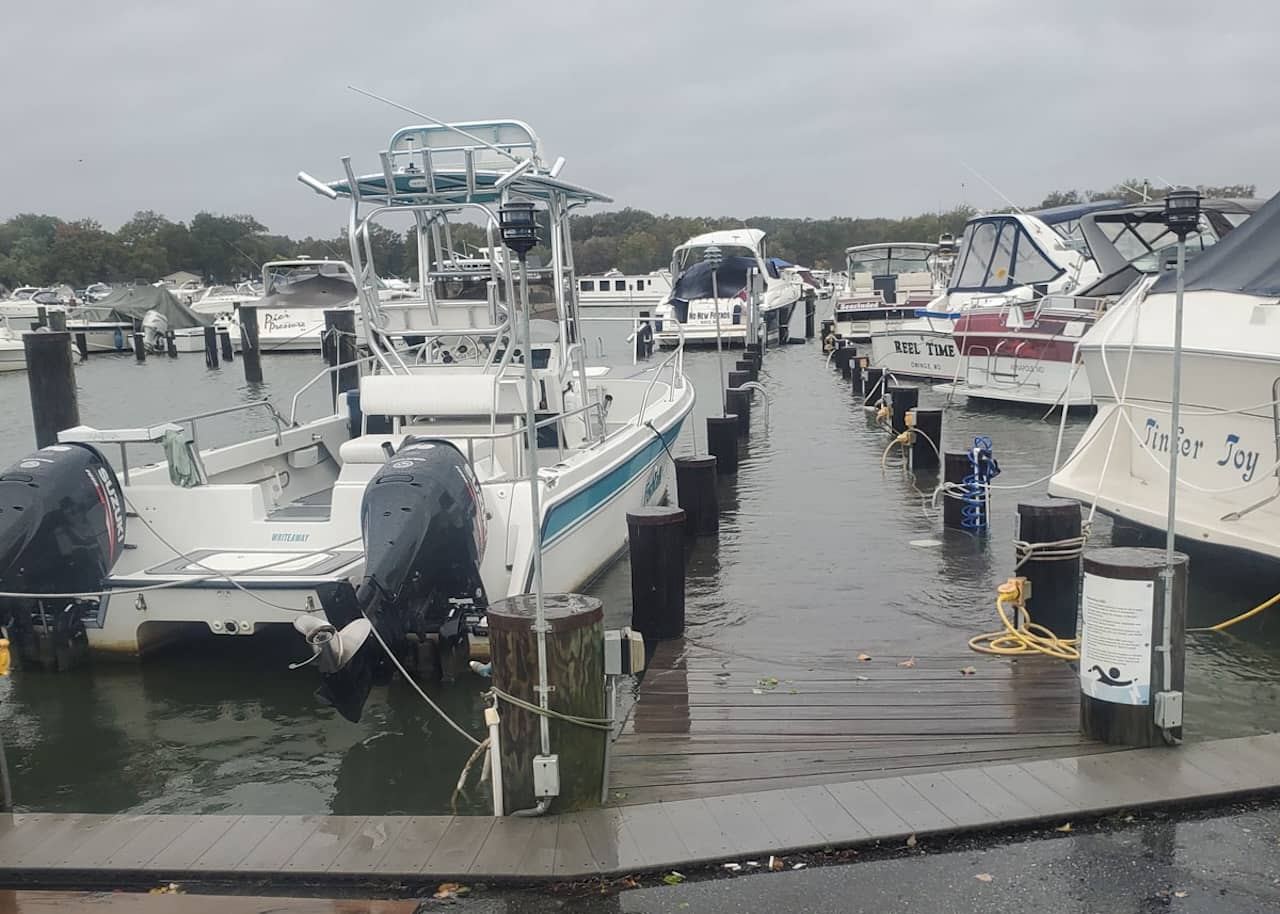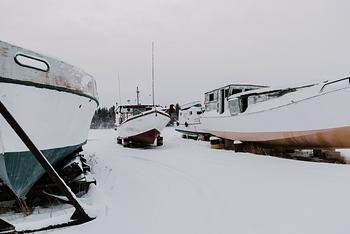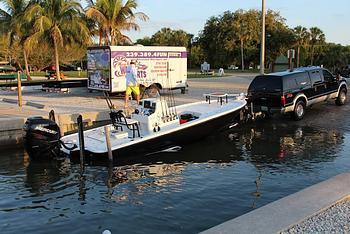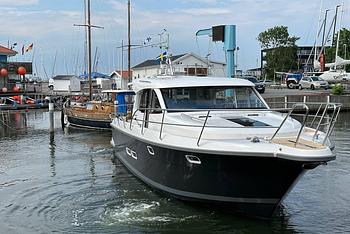No matter what type of vessel you have and wherever you may be storing your boat, when a hurricane threatens the coast you’ll need to take quick action to ensure its safety. Hurricanes bring destructive winds, storm surges, abnormal waves, and excessive rainfall. Any one of these can damage a boat and all of them combined can destroy one. Hurricane Sandy in 2012 was one of the most destructive ever, damaging over 65,000 boats and resulting in over $650 million in losses. Hurricane Irma damaged or destroyed 50,000 in 2017. And in 2022 Hurricane Ian took out another 7,000 boats. Anytime a hurricane approaches the coast, you can bet every boat in the area is at risk—and how you prep your boat before a hurricane’s arrival is critical.
- One Week Before the Hurricane
- Three Days Before a Hurricane
- One Day Before a Hurricane
- Boats in a Slip During a Hurricane
- Boats at Anchor or on Moorings During a Hurricane
- Boats on Land During a Hurricane
- After the Hurricane Passes

Hurricanes demand careful preparation from boat owners. Satellite image of hurricane Katrina by NOAA.
One Week Before the Hurricane
The number-one way to reduce the chances of hurricane damage to a boat is to get it out of the water and onto dry land. A full week before a hurricane is expected to hit there will still be a lot of uncertainty in the forecast, and exactly where it will go is usually an open question. So it may be premature to move your boat out of the water and onto land if doing so is a big, expensive endeavor. However, it’s not too soon to begin thinking about your options, and making sure your schedule will allow for immediate action in the coming days.
When the forecast becomes more reliable and the hurricane is just few days out, you can be sure that every boat yard with a lift and every launch facility with a ramp will become incredibly busy. It’s not unusual for some boat owners who waited until it was too late to be unable to arrange for a haul-out. So don’t wait until the last minute. A week ahead isn’t too early to get your name on their list in case hauling the boat becomes necessary in the next few days.
If you have a trailer for your boat and can pull it yourself without any big expense or inconvenience, go ahead and do so now. Pay close attention, however, to where you park it for the storm. Naturally, indoors in a garage or other building is the best-case scenario, but many people won’t have that option. Remember that leaving the trailer on soft ground can be problematic, and if at all possible stay away from large trees where there’s the possibility of damage from falling limbs. Also try to avoid areas where falling powerlines could be a problem.

Pay close attention to where you park your boat during a hurricane—including keeping it away from areas where downed power lines could result in a catastrophe like this.
Three Days Before a Hurricane
Most people would consider this the critical stage. At this point you should be able to see fairly accurate predictions and know whether the cone of probable impact will include your boat’s location. If you don’t already have your boat out of the water, act immediately. If you have it out on land, you can work ahead on additional preparation measures.
This is a good time to remove valuable accessories that could be damaged, just in case. Take off any removable electronics and store them at home. If your boat has a dinghy or tender that’s normally stored aboard, remove it and secure it separately. You’ll also want to remove personal effects that may be difficult to replace. The boat’s paperwork like the registration and licenses, for example, or anything holding sentimental value. Portable outboards can also be removed and stored in a safe place. Bimini tops, Isinglass panels, any exposed sails and even the boom on a sailboat, and any other items that could be subject to wind damage and/or increase a boat’s windage should be removed, as well. Even when boats are stored ashore some get blown off the stands, so reducing a boat’s windage in every way possible is a good move.
Depending on size, type, and location, there’s some possibility that getting the boat out of the water will at this point appear to be a problem. If so, now’s the time to consider moving it. You may be able to take the boat out of the hurricane’s path or at least move it to a safer area than it currently sits. Boats on moorings exposed to the wind and waves, for example, often fare better if moved to a protected “hurricane hole.”
If you do move your boat, however, it’s more important than ever to follow all of the boating safety tips and top sailing safety tips. The last thing in the world you want to happen is for a mishap to occur while you’re aboard as a hurricane is bearing down on the area. Ensure that the boat’s mechanical systems are in tip-top shape before risking a move, or you could make matters worse or potentially even place yourself in danger.

If you have a trailer, get that boat out of the water asap.
One Day Before a Hurricane
At this point hopefully your boat is high and dry. If not, you may have to prep for an in-the-water hurricane strike. If so, your next actions depend on whether the boat is moored in a wet slip, or is at anchor or on a mooring. Note: do NOT plan to stay aboard the boat and “ride it out.” You may be worried about your boat but you should be a lot more worried about your own well-being, and you belong in a safe place on dry land when the hurricane hits.
Boats in a Slip During a Hurricane
Boats in wet slips should have additional lines placed wherever possible, on as many different cleats as possible to best distribute the load. Doubling the usual number of lines is generally considered appropriate. Lines need additional scope, too, to account for storm surge. It’s best to remove short lines affixed to low pilings or cleats, and replace them with lines affixed to points as high as possible. Make them as long as possible, including affixing them to pilings that are farther away if any are available. Chafe gear should be added wherever the lines may rub against anything, including parts of the boat itself. If lengthening the lines makes the boat more likely to contact with a pier or piling add fenders wherever applicable.
It’s also a good idea to put on a battery charger and top off the battery’s charge, even if the boat is plugged in. A loss of marina electricity is very common during hurricanes, and there’s a good chance your boat’s bilge pumps will be working overtime. In fact, wise mariners will also check all pumps to make sure they’re functioning properly, inspect scuppers to make sure there aren’t any clogs, and remove anything like loose rags or detritus that could run to the scuppers and clog them.

Hurricanes are not kind to boats left in the water; Maria did these vessels in. Photo by Petty Officer 2nd Class Lauren Steenson, courtesy of the United States Coast Guard.
Boats at Anchor or on Moorings During a Hurricane
Leaving a boat at anchor or on a mooring during a hurricane should be a last resort, especially if it’s in the direct path of the storm. At the very least, hopefully you’ve moved the boat as far as possible from where the storm will make landfall. And even in a well-protected hurricane hole, boats will be at more risk than if they were ashore. Still, there are a few things you can do to reduce the chances of damage.
As with boats on land, remove everything of value that could be damaged and anything that could increase the boat’s windage, ensure batteries are fully charged, inspect the scuppers for clogs, and inspect the boat for loose items that could become potential clogs. In addition, increase the amount of scope as much as is practically possible. If you’re depending on an anchor, if practical it’s best to set a second anchor with the two lines in a wide V-shape about 45-degrees to one another, meeting at the bow cleat(s). Obviously you should use the largest anchors possible (and of appropriate design for the bottom composition), but if you don’t have identical anchors, set the larger one towards the direction of the anticipated highest winds.
Some hurricane holes or anchorages will be very close to land, and in this case, you may also be able to run lines to shore. Burying additional anchors on shore on either side of the boat or even tying off to stout trees can help secure the boat in position.

Storm surge is a major danger during hurricanes, so boats in wet slips need to be secured with extra lines long enough to allow the boat to float significantly higher than usual.
Boats on Land During a Hurricane
If your boat is on dry land, the hurricane prep isn’t necessarily complete. If possible, adding straps securing your boat to the ground will add another layer of protection. In many marinas and boatyards, this will be up to the professionals, and some may even have pre-drilled holes in paved lots with sleeves that eye bolts can be screwed into. Otherwise, helical screw anchors with eye bolts can be added to unpaved ground as anchor points. In either case, if having the yard add straps is a possibility, request it. And if you have the boat stored at home but are in a low-lying area or the rig will be exposed to the full force of the wind, adding screw anchors and straps yourself is a good move.
Also inspect the boat to be sure it will drain properly since excessive rainfall is in store. Boats on land should have drain plugs removed and scuppers should be clear so water can exit the boat as easily as possible. Resist the temptation to put on a cover, because in hurricane force winds covers of any type are likely to be shredded as well as adding windage to the boat.
After the Hurricane Passes
We hope that after taking all these measures, Mom’s Mink came through the storm with flying colors. But reality dictates that in a hurricane, some boats will be damaged no matter how much prep work you do. So, post-hurricane step number one is to inspect your boat for damage. Remember, however, that marinas, docks, and anywhere around the water can be dangerous immediately following a significant storm. You could encounter fuel or sewerage leaks, downed electrical lines, missing or loose dock boards, and many other hazards. Make sure the area is safe before entering, and don’t bring children to areas you haven’t already checked out.
If you find your boat safe and sound, you can celebrate and make plans for relaunching it or moving it back to its home after storm cleanup is complete. Remember, however, that in many areas there will be plenty of hazardous flotsam like tree limbs and boards floating in the water, so it might be best to delay any significant cruises for the time being.
If you find your boat has been damaged, you should contact your insurance company immediately for instructions on how to proceed. Don’t initiate any salvage or repair work yet, because the insurer will likely want to have one of its representatives or a certified marine surveyor check the boat out and make a determination as to how to best handle the work. And no matter how bad off the boat may be, remember that boats can always be fixed or replaced—it may take some time, but sooner or later you’ll be back out on the water enjoying the boating lifestyle.

Debris can be a major post-hurricane problem, so avoid any damage after the storm by delaying any big cruises. Photo by NOAA.



